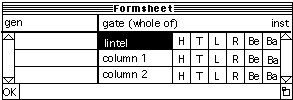|

Formsheet, design data manager,
draft proposal. 1998, 68 pages, unpublished paper
_____________________________
Finding ways to make the computer truly participate in designing and not just be a glorified drafting tool, seems to me a critical issue.
The problem is not primarily one of programming. It is one of knowing about designing. We must first be able to tell the machine what to do and what to understand. This is a matter of design theory, particularly of theory about the way designers communicate about the transformation of form. Here designers are at a disadvantage, compared to other disciplines employing the computer, because we do not have an explicit and common theory about the methods we apply when designing. Without it we cannot expect the computer to work with us. The spreadsheet, for instance, could be developed successfully because there was already a well established method of accounting and of mathematical interactions of numbers.
A few years ago I wrote a proposal for 'formsheet'; a program that would allow us to communicate with the machine about the interaction of forms. This is not a working application - I do not know how to program - but a description of a possible interface between designer and computer and the way the dynamics of form transformation can be communicated with the computer.
The proposal has four major aspects. Firstly it is about a new interface between computer and designer that I believe to be faster and more congruent with actual design thinking about the manipulation of form. Secondly it introduces a number of relational concepts that govern form transformations. Thirdly it deals with form abstraction by which a complex configuration can be reduced to a single form and a single form can be re-specified as a configuration. Finally, it wants all transformations to be fully 'bi-directional', that is to say: not only is what we change in the graphic representation of the form stored in the database that contains all the design information, but any change in the database is instantly translated in a change of the design.
The 'formsheet' draft report contains 68 'sheets' illustrating the operations proposed. The introductory sheet is given here.
( john@habraken.org)
|